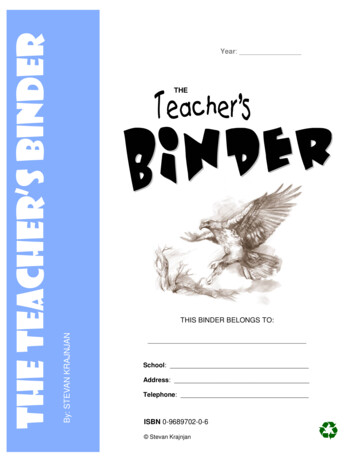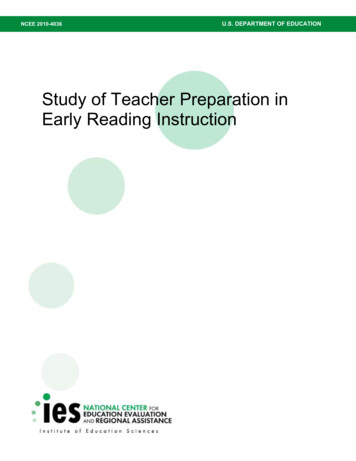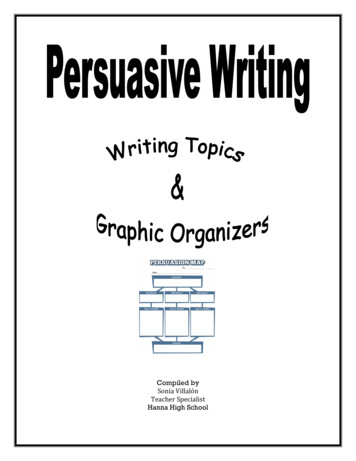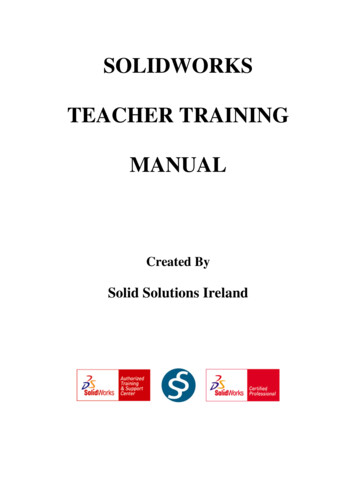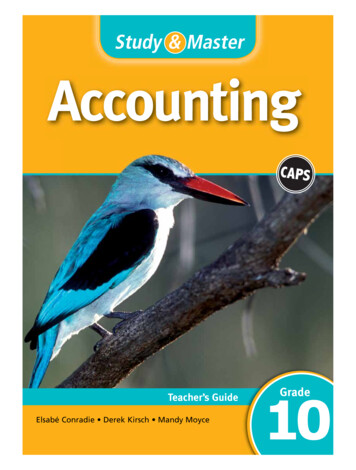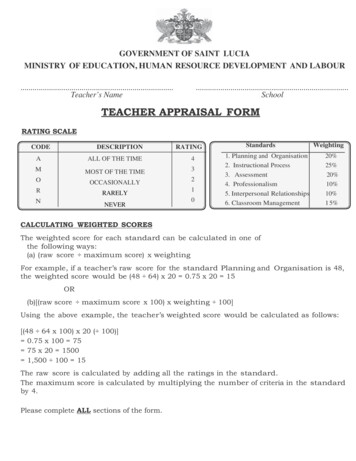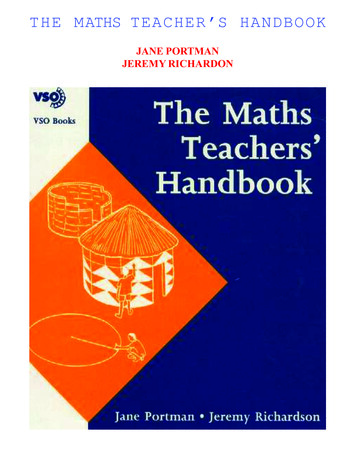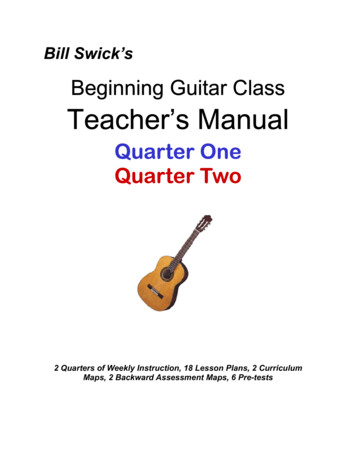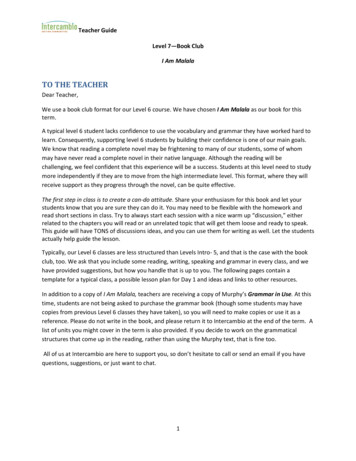
Transcription
Teacher GuideLevel 7—Book ClubI Am MalalaTO THE TEACHERDear Teacher,We use a book club format for our Level 6 course. We have chosen I Am Malala as our book for thisterm.A typical level 6 student lacks confidence to use the vocabulary and grammar they have worked hard tolearn. Consequently, supporting level 6 students by building their confidence is one of our main goals.We know that reading a complete novel may be frightening to many of our students, some of whommay have never read a complete novel in their native language. Although the reading will bechallenging, we feel confident that this experience will be a success. Students at this level need to studymore independently if they are to move from the high intermediate level. This format, where they willreceive support as they progress through the novel, can be quite effective.The first step in class is to create a can-do attitude. Share your enthusiasm for this book and let yourstudents know that you are sure they can do it. You may need to be flexible with the homework andread short sections in class. Try to always start each session with a nice warm up “discussion,” eitherrelated to the chapters you will read or an unrelated topic that will get them loose and ready to speak.This guide will have TONS of discussions ideas, and you can use them for writing as well. Let the studentsactually help guide the lesson.Typically, our Level 6 classes are less structured than Levels Intro- 5, and that is the case with the bookclub, too. We ask that you include some reading, writing, speaking and grammar in every class, and wehave provided suggestions, but how you handle that is up to you. The following pages contain atemplate for a typical class, a possible lesson plan for Day 1 and ideas and links to other resources.In addition to a copy of I Am Malala, teachers are receiving a copy of Murphy’s Grammar in Use. At thistime, students are not being asked to purchase the grammar book (though some students may havecopies from previous Level 6 classes they have taken), so you will need to make copies or use it as areference. Please do not write in the book, and please return it to Intercambio at the end of the term. Alist of units you might cover in the term is also provided. If you decide to work on the grammaticalstructures that come up in the reading, rather than using the Murphy text, that is fine too.All of us at Intercambio are here to support you, so don’t hesitate to call or send an email if you havequestions, suggestions, or just want to chat.1
Teacher GuideContentsTO THE TEACHER . 1OBJECTIVES . 3SUGGESTED BREAKDOWN FOR READING . 4SUGGESTIONS . 6STRUCTURE OF A TYPICAL CLASS . 8DAY 1 . 10MAJOR THEMES . 12QUOTES TO DISCUSS . 13RESEARCH PROJECT AND PRESENTATION . 22ONLINE RESOURCES . 22SUGGESTED UNITS FOR GRAMMAR STUDY . 23READING ALOUD RUBRIC . 252
Teacher GuideOBJECTIVESAt the end of the 16-18 sessions this term, students Will have completed one book Will have learned at least 100 new vocabulary words Will have given oral presentations and/or participated in debates Will have practiced grammar points Will have completed journal entries (for fluency) as well as more formal writing tasks forcorrection Will have read aloud to work on their pronunciation, and been rated using a rubric3
Teacher GuideSUGGESTED BREAKDOWN FOR READINGI am Malala has 36 chapters, a prologue and epilogue. Students should do the majority of the reading athome. We recommend assigning the majority of the reading for homework and then choosing one ortwo short sections of the chapters to read aloud in class. The suggested reading plan below is designedwith 17 classes in mind. Make adjustments as necessary for your group. Note that the reading should beassigned as homework in the previous class so that the discussion will take place on the “class” dayClassChapter1Prologue2Part 11. As Free as a Bird2. Dreams3. A Magic Pencil4. A Warning from God5. The First Direct ThreatPart 26. Radio Mullah7. The Taliban in Swat8. No One Is Safe9. Candy from the Sky10. What Terrorism Feels LikePart 311. A Chance to Speak12. A Schoolgirl’s Diary13. Class Dismissed14. Secret School15. Peace?16. Displaced17. Home18. A Humble Request and a Strange Peace19. Good News at lastPart 420. A Death Threat against Me21. The Promise of Spring22. Omens 123-12623. A Day Like Any 26127-130# of# of pgs. forpgs./chapter homework7(cover in classon day 1)1014 (assign ashw on day 1)4412351257414461248515468113473143344
Teacher Guide11121314151617Part 524. A Place Called Birmingham25. Problems, Solutions26. A Hundred Questions27. Passing the Hours28. We Are All Here Now29. Filling In the Blanks30. Messages from Around the World31. A Bittersweet Day32. Miracles33. This New Place34. The One Thing We All Know35. Anniversary36. One Girl Among ManyEpilogue: October 4-2045536682546435119141110811
Teacher GuideSUGGESTIONSVocabularyThere will be many words that students may be unfamiliar with. Don’t feel that you have to explainthem all, and make sure your students know they don’t have to learn them all. Work on words that arehigh frequency, or that are necessary for understanding the chapter. Have students pick the words theywant to learn: For homework, ask students to bring in 3-5 words from the reading to share with a partner andthen the whole class. Tell students to write the page number and sentence where they foundthe word, the meaning, and then an original sentence with the word.In class, have them explain the meaning to his/her partner in their own words and share theirsentence. Then have some of the students share with the class.For the first class, have them do it in class with a partner.When possible, act out the actions with your students; this can help fix the meaning in theirminds.Writing Activities Two types of writing should be worked on during the course: Journal Writing and WritingAssignments Journal Writing - Students should write a journal entry in their notebook after (or during)every class. Option – provide students with a question to answer. Option – have them copy a sentence or paragraph that they find interesting fromthe book, and write their opinion about it. In general, the teacher should respond to the content of the journal entry ratherthan correcting the grammar. Writing Assignments Assign students a short paragraph. Collect these and give feedback. Have thestudents rewrite the paragraph. Many of the discussion questions can serve as topics for writing.Reading Activities Encourage your students to practice “skimming” (reading quickly without stopping to lookup individual words). The idea of extensive reading is not to understand every single word,but rather to understand most of the content despite the unknown words. Research showsthat we actually retain more when we read something quickly several times rather than6
Teacher Guide reading it slowly once. And one of the biggest detriments to confidence-building forstudents is believing they have to understand every word they read or hear.Reading short sections aloud can be a useful activity for practicing pronunciation. Havestudents read the section silently first to prepare them for reading aloud.If students don’t come to class prepared, assign different chapters to different students.Most chapters are quite short. After they read their chapter, they can share what happenedwith the class so that everyone gets the main idea.Grammar Use Grammar in Use to cover a grammar point each class. Students will not have the book, soyou need to either make copies or use it as a reference. Please do not write in the book as youwill need to return it to Intercambio at the end of the term. You can pick a topic a few ways:o Choose a topic which comes up in the reading.o Choose a topic you notice students struggling with when speaking and/or writing.o Follow the schedule provided at the back of this packet for “for “Grammar in Use,summer term.”Speaking Students should have ample speaking opportunities in class. When they are involved in bookdiscussion, take notes and go over their mistakes at the end. Be sure to ask questions thatallow everyone to participate, even those who may not have done the reading.Have students read aloud (after they’ve read silently) and give feedback using the rubricprovided. (Make copies as necessary). Don’t forget to give feedback on pronunciation.Debates work well at this level. Divide your class into two teams and have them debate atopic from the book.Assign a more formal speaking presentation. Record the student (using their own phone) sothey can listen to themselves and see where they need more practice. Perhaps a student isassigned to give a chapter summary at the start of each class. This is greatspeaking/presenting practice and is also a great way to help students who haven’t done thereading (or didn’t understand the reading) feel as though they can actively engage in theremainder of the class.Speaking homework can also be assigned using students’ cell phones. Have them record avoice message as they read a passage from the book, and then send it to you. WhatsApp is agreat app for this because it works on Wi-Fi, and doesn’t use students’ data.Field Trip Going to the library to check out other formats of the book is a great option. Going to a coffeeshop to discuss the book can also be a lot of fun.7
Teacher GuideSTRUCTURE OF A TYPICAL CLASSWarm up (review) Review vocabulary from previous classes with flashcards or a game. Games like tic-tac-toe,bingo, hangman and concentration are good for this.Use one of the discussion questions as a warm up.Check Homework Option – Have students read each other’s journal entries, and respond with a sentence or two.Option – Collect sentences students have written and correct themOption – Have students write a sentence on the board and correct with whole class.Discussion of Reading Discuss reading that was assigned from previous class.Be sure to ask a few opinion questions that all students can answer (even if they have not donethe reading.)If reading was assigned for homework, you may want to give a few minutes forthem to skim it to remember what was read.Vocabulary Study Vocabulary study should take place at two times during the classo Before reading – If you think it’s necessary and important for understanding, introduce acouple words in the next chapter(s) that you feel are important and may be difficult foryour students.o After reading – students may choose the words they want to learn, or work from a listthe teacher has generated. We recommend each student picks 3-5 words from thereading to look up, write a sentence for and then share with the class. Activities withvocabulary flash cards and writing activities such as using words in a sentence are workwell.o There will be many words that students may be unfamiliar with. Don’t feel that youhave to explain them all, and make sure your students know they don’t have to learnthem all. Work on words that are high frequency, or that are necessary forunderstanding the chapter.o Allow some class time every session to review previously studied vocabulary.Grammar Study Grammar in Use has simple explanations and practice items. Based on a difficult structure fromthe reading, or other grammar points your students need work on, choose a grammar point forthe day. You can also use the schedule provided at the back of this packet for suggestions.8
Teacher GuideJournal Writing Students should write a journal entry in their notebook after (or during) every class.Option – provide students with a question to answer (the pre-reading questions on page 6would work well for this).Option – have them copy a sentence or paragraph that they find interesting from the book, andwrite their opinion about it.In general, the teacher should respond to the content of the journal entry rather than correctingthe grammar.Wrap up Suggestions Have students predict what will happen nextHave students draw a picture or do some kind of artwork to show what was discussed in classHave students fill out an exit ticket with information such as:o A new word I learned todayo Something I enjoyed in class todayo Something that is still unclear to meo Something I need to work onHomework Assign writing homework each class. A journal entry should be done every class. A more formalwriting assignment should be done at least once every 2 weeks. Writing need only be a fewsentences, depending on the level of your students.Assign some reading as homework each class.Other suggestionso If students do their journal entries in class, then the homework could be to write aparagraph about the same topic to turn in for correction.o Have students write 5-10 sentences with new vocabulary.9
Teacher GuideDAY 1Icebreaker (about 10 minutes) Make sure students share their names with each other.Put your name and contact info on the board and have students copy it.A fun icebreaker is to have everyone stand up in the middle of the room and then call out twoopposite things, e.g. beach /mountains, drive/walk, summer/winter, tacos/hamburgers, earlymorning/late night, etc. Students go to one side of the room or the other based on theirpreferences. After each choice, have students discuss their preferences with others on theirside, or with the whole group.Objectives and Goal Setting (10 minutes) Put the objectives for the course (p. 3) on the board.Have students write at least two personal goals for the course in their notebooks. Have themshare the goals with a partner.Class expectations and assessment (5 minutes) Together with your students, set expectations for the course.Attendance – students with no absences will get a scholarship for the next course tuition andmaterial. Students with one excused absence will get a scholarship for the next course tuition.Homework – homework should be assigned every class session. Students should do somereading and writing at home. Work with your class to decide how much they will read at home.Assign written homework after every class. Once again, negotiate with your class about whatyou expect and what is reasonable for them to do.Assessment in Level 6 is handled informally. There are no official final exams. However, teacherswill fill out a report card at the end of the term. Students should receive feedback during classon their writing, speaking (fluency and pronunciation) and grammar.For reading aloud, use the attached rubric to rate your students.10
Teacher GuidePre reading Activities (20)Ask students what they know about Malala. You can: Create a timeline of important events on the board (point out the additional information in thebook beginning on page 213)have students make word webs. They should write the name Malala in the center of the page ina circle and draw lines from it. Each line connects with a piece of information related to Malala.This can be done individually or on the board.Bring a map to show the where Malala lived. If you have a computer, this is a great s/Cascade/index.html?appid b0d16762a67949f392c5a43b87fa6fe8Consider showing part of one of the videos suggested in this guide.Break (10)Reading (30)Read the first section of the Prologue (Pg. 1—through the break on pg. 3) out loud and then discuss it.Since it’s short, you can read it a couple times. In this section, Malala describes her home in Pakistan andher home in Birmingham. Ask students to describe the house where they grew up. Ask, “What do youremember about the house? What makes that house so memorable and important to you?” Encouragethem to ask for and provide details. Next have students take turns reading so you can get a feel for their pronunciation and thenwork on their pronunciation needs during the term. (Limit their reading aloud to about aparagraph. Give them a chance to read that section silently before reading aloud.)Vocabulary (20) For future classes, have students choose 3-5 words for homework. Students should write themeaning and an original sentence using the word. During the following class, students willexplain the meaning to his/her partner in their own words and their share it with the class.Since this is the first class, have them choose 1 or 2 words from the Prologue and do the abovewith a partner. If time permits, have them share it with the class.If you pick a word, concentrate on high frequency vocabulary, or words that are important tounderstand the text.11
Teacher GuideEnd class and assign homework (5 min) Assign Homework: Read Chapters 1 and 2. Remind students to select 3-5 words to write thedefinitions for and use in an original sentence to share next class. If desired, give them aquestion or two about the reading to answer as well.Assign a journal entry such as the one suggested for Chapter 1: What are some traditions of yourculture? How do those traditions impact your family traditions?Hand out ½ sheets of paper and have each student write an answer to these 2 questions.Answers could be a word or a complete sentence. Have them turn it in to you as they leave.1. How do you feel right now?2. What is something you learned in class today?MAJOR THEMESGender and Gender Inequality — Throughout the memoir, Malala struggles with her place as a womanin Swat; she must overcome the constraints society places on her in order to pursue her education andbe herself.Education — Malala and her father believe that all children have the right to go to school. They use thisstrong belief as fuel to speak out against the Taliban.Fear vs. Courage — Malala fights her circumstances by having the courage to stand before others—risking her life—to speak on behalf of her people.(source: ow-to-teach-i-am-malala)12
Teacher GuideQUOTES TO DISCUSSThese can be used as a warm up for your class, pre-reading questions, or as discussion questions afterreading.15 Powerful Quotes from I Am Malala (source: https://www.movemequotes.com/i-am-malala/) “I’ve always been a daydreamer, and sometimes in lessons my mind would drift and I’d imaginethat on the way home a terrorist might jump out and shoot me on those steps. I wonderedwhat I would do. Maybe I’d take off my shoes and hit him, but then I’d think if I did that therewould be no difference between me and a terrorist. It would be better to plead, ‘OK, shoot me,but first listen to me. What you are doing is wrong. I’m not against you personally, I just wantevery girl to go to school.’” (Pg. 6)“I was a girl in a land where rifles are fired in celebration of a son, while daughters are hiddenaway behind a curtain, their role in life simply to prepare food and give birth to children.” (Pg.13)“Education had been a great gift for him [Ziauddin]. He believed that lack of education was theroot of all the Pakistan’s problems. Ignorance allowed politicians to fool people and badadministrators to be reelected. He believed schooling should be available for all, rich and poor,boys and girls.” (Pg. 41)“I think everyone makes a mistake at least once in their life. The important thing is what youlearn from it. That’s why I have problems with our Pashtunwali code. We are supposed to takerevenge for wrongs done to us, but where does that end? If a man in one family is killed or hurtby another man, revenge must be exacted to restore nang (honor).” (Pg. 72)“We felt like the Taliban saw us as little dolls to control, telling us what to do and how to dress. Ithought if God wanted us to be like that He wouldn’t have made us all different.” (Pg. 124)“My father would say to me, ‘Any organization which works for peace, I will join. If you want toresolve a dispute or come out from conflict, the very first thing is to speak the truth. If you havea headache and tell the doctor you have a stomachache, how can the doctor help? You mustspeak the truth. The truth will abolish fear.'” (Pg. 139)“My father used to say the people of Swat and the teachers would continue to educate ourchildren until the last room, the last teacher and the last student was alive. My parents neveronce suggested I should withdraw from school, ever. Though we loved school, we hadn’trealized how important education was until the Taliban tried to stop us.” (Pg. 146)“As we crossed the Malakand Pass I saw a young girl selling oranges. She was scratching markson a piece of paper with a pencil to account for the oranges she had sold, as she could not reador write. I took a photo of her and vowed I would do everything in my power to help educategirls just like her. This was the war I was going to fight.” (Pg. 217)13
Teacher Guide “Then they told me about the call from home and that they were taking the threats seriously. Idon’t know why, but hearing I was being targeted did not worry me. It seemed to me thateveryone knows they will die one day. My feeling was nobody can stop death; it doesn’t matterif it comes from a Talib or cancer. So I should do whatever I want to do.” (Pg. 224)“My father was convinced the Taliban would hunt him down and kill him, but he again refusedsecurity from the police. ‘If you go around with a lot of security the Taliban will use Kalashnikovsor suicide bombers and more people will be killed,’ he said. ‘At least I’ll be killed alone.'” (Pg.233)“She explained that the bullet had entered through the side of my left eye where there was ascar, traveled eighteen inches down to my left shoulder and stopped there. It could have takenout my eye or gone into my brain. It was a miracle I was alive.” (Pg. 282)“We human beings don’t realize how great God is. He has given us an extraordinary brain and asensitive loving heart. He has blessed us with two lips to talk and express our feelings, two eyeswhich see a world of colors and beauty, two feet which walk on the road of life, two hands towork for us, a nose which smells the beauty of fragrance, and two ears to hear the words oflove.” (Pg. 300)“I don’t want to be thought of as the ‘girl who was shot by the Taliban’ but the ‘girl who foughtfor education. This is the cause to which I want to devote my life.” (Pg. 309)“‘Let us pick up our books and our pens,’ I said. ‘They are our most powerful weapons. Onechild, one teacher, one book and one pen can change the world.'” (Pg. 310)“Peace in every home, every street, every village, every country – this is my dream. Educationfor every boy and every girl in the world. To sit down on a chair and read my books with all myfriends at school is my right. To see each and every human being with a smile of happiness is mywish.” (Pg. 313)14
Teacher GuideCOMPREHENSION AND DISCUSSION QUESTIONSStudents can write answers to the discussion questions in class or for homework. Either way, please givestudents time to discuss their answers in pairs and then as a class.Part 1: Before the TalibanChapter 1 How was Malala like typical Pashtun girl in Pakistan? In what way was she different? What was her father's dream? Do you relate to Malala? If so, in what ways? If not, why not? What aspects of Malala’s culture are presented in Chapter 1? (Pashtun hospitality, scarves,burqas, prophets, male / female, Malalai, kites, the side road)JournalWhat are some traditions of your culture? How do those traditions impact your family traditions?Chapter 2 What is life like in the village? What are the freedoms and the restrictions? How is Malala first introduced to the existence of the Taliban? What threat do they pose?JournalWhat was your favorite place as a child? Describe it through your child eyes and then as an adult.Chapter 3 Why is this chapter called Magic Pencil? How does Malala’s faith influence the way she sees the world and her place in it? Describe Malala’s mother and father.Chapter 4 Why is this chapter called “A Warning from God”? How did the earthquake and its aftermath make Pakistan vulnerable to the Taliban?Chapter 5 What's the first direct threat? How does Malala see her school? How do others see her school (neighborhood boy and the 6elders)? How do most Pakistani study the Koran? How does Malala?JournalDescribe a childhood friend. Compare and contrast to Malala’s friendship with Moniba.15
Teacher GuidePart 2: A Shadow Over Our ValleyChapter 6 What was radio Mullah? How did people respond to him? Who was behind the voice on theradio? Describe the progression of the talks. What was 9/11?Chapter 7 Answer Malala's question: How did an unschooled fanatic turn himself into a kind of radio god?And why was no one prepared to defy him? (p. 47) How did Malala's family respond to the increasing restrictions/rising fear? How did the restrictions increase? How did this impact the school? How did Malala's parents respond? What finally turned Malala's frustration to fear?Chapter 8 What did the newspaper add to Malala's father’s letter that may have put the school at greaterrisk? How does Benzair Bhutto show no one is safe? How does this impact Malala's resolve?Chapter 9 Why is the title of this chapter “Candy in the Sky”? How is it ironic? What is Malala's prayer?Chapter 10 Why is school such a haven for Malala? How does the Taliban tear away at it? How does Malala describe terrorism? How does it snuff out life? Why do you think Fazlullah attacks at night?JournalAt the end of this chapter, Malala’s father says, “At night our fear is strong, but in the morning, in thelight, we find our courage again.” (pg. 65) Have you found this to be true? What brings you hope duringhard times?16
Teacher GuidePart 3: Finding My VoiceChapter 11 Why was it important for the girls at Malala’s school to speak about their experiences? How is Malala transformed when she speaks?JournalMalala bravely spoke out, along with her schoolmates. Talk about a time when you had to be brave.Chapter 12 How is Malala’s prayer for a magic pencil answered in this chapter? What was going to happen on January 15th? Why do father's pull their daughters out of schoolearlier?JournalImagine that your daughter is attending school during this time. What would you do? Why?Chapter 13 Why do you think the TV crews wanted to follow Malala? What did the girl who came to school against her father's wishes risk?JournalHas there ever been a time you felt enough conviction to go against a family member’s wishes? Writeabout it. If not, can you imagine an issue that would make you go against him or her?Chapter 14 How does the war show up in the children's game? What are your thoughts on this? What is the change in circumstances that allows Malala to attend school secretly? At what risk?JournalWhat's a game you played as a child? How did it reflect the place and time where you grew up?Chapter 15 Where does Malala’s boldness to speak come from? What's the impact of her interviews? Why is the chapter called “Peace”?JournalMalala sees the power of the media in this chapter. Talk about how the media’s power has been usedfor both good and bad in her life. What makes it so powerful? How have you seen this in the US, or inyour own country?Chapter 16 Why do Malala and her family leave Swat? Why is her family surprised to see them? Why does the US ambassador laugh at Malala’s question?JournalFor Malala it was her books, for her brother it was his chicks. If you had to leave your home and couldonly take what you could carry, what would you be saddest to leave?17
Teacher GuideChapter 17 Describe the Swat her family returns to. What does Malala’s father's mean when he says, "First the people of Swat fall under the spell ofthe Taliban, then we are killed by the Taliban, and now they are blamed for the Taliban!" (Pg.106)Chapter 18 Describe what the chapter name is talking about.JournalMalala sees her height as an obstacle to her purpose. Do you agree with her? What obstacle do youthink gets in the way of your purpose?Chapter 19 What honors does Malala receive? How does she use them? Why does her father frown when she receives a prize named after her—The Malala Prize?JournalRather than being jealous of her as Malala fears, her friends rally around her. Describe a time whenyou've seen the power of support or the damage of jealousy.Part 4: TargetedChapter 20 H
I Am Malala TO THE TEACHER Dear Teacher, We use a book club format for our Level 6 course. We have chosen I Am Malala as our book for this term. A typical level 6 student lacks confidence to use the vocabulary and grammar they have worked hard to learn. Consequently, supporting level 6 studen

